Swine production and challenges in Vietnam after african swine fever: A case study in Peri-Urban Hanoi, Vietnam
The goal of this paper was to identify major challenges in rebuilding
the swine industry in Vietnam, using the Chuong My district, Hanoi
as a case study. Primary data was gathered in 2020 mainly through a
survey of 97 swine producers in the district. Analysis tools were
descriptive and comparative statistics. Results show that after the
African swine fever (ASF) outbreak, the recovery of the swine
industry in Vietnam faced several challenges, including the issues of
piglet quantity and quality, changing consumer preferences which
were worsened by the current Covid-19 pandemic, relatively cost
disadvantage of domestic production under the context of new free
trade agreements, disease risk (ASF under the condition of no
effective and safe vaccine), insufficient resources of farms to restock,
and environmental issues caused by swine production in rural areas.
The paper proposed several recommendations to rebuilding the swine
herd in order to address the issues and overcome the challenges,
mainly focus on improving sow quality, market information and
linkages, good practices in production, training for labor, and address
environmental issues.

Trang 1
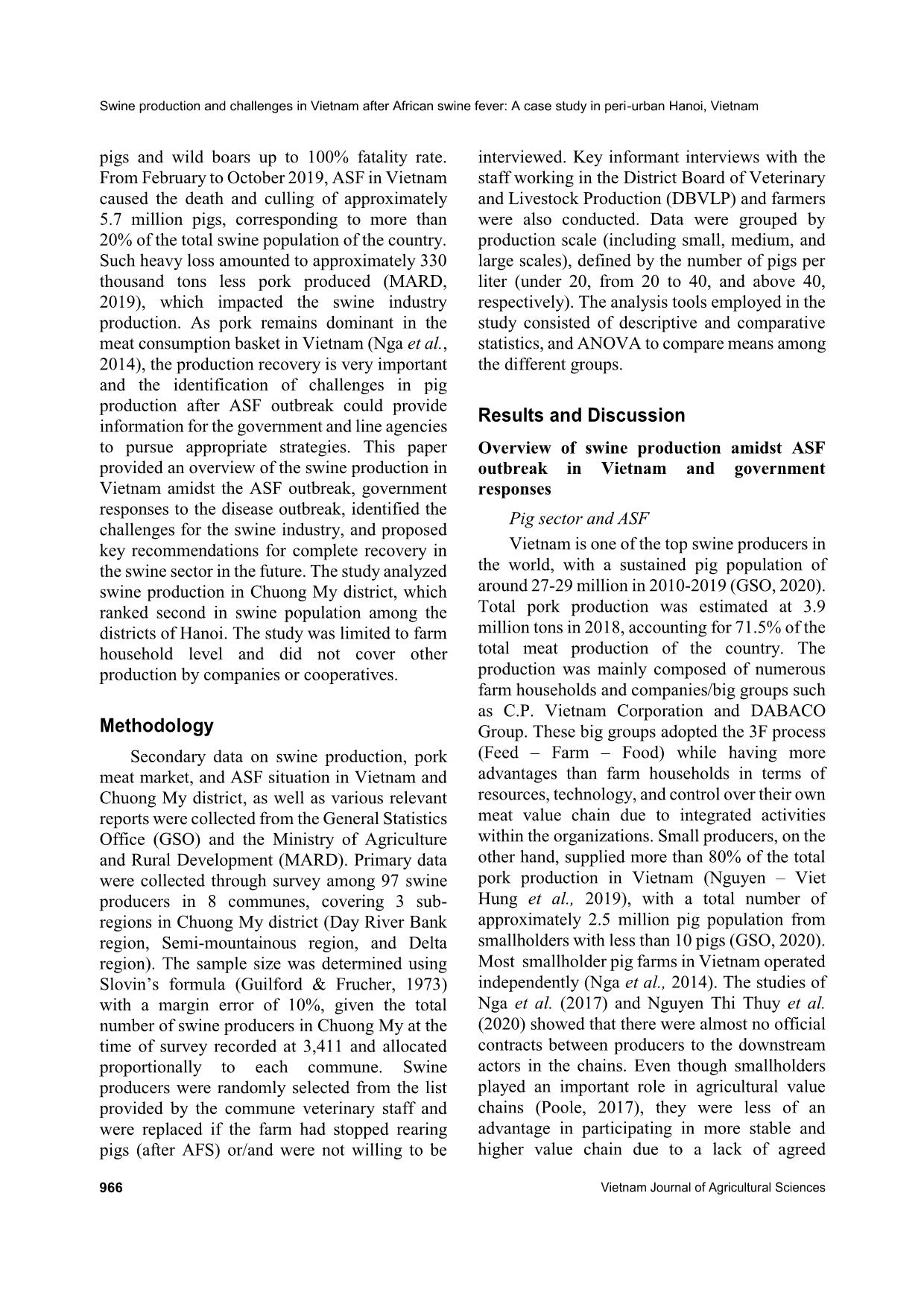
Trang 2

Trang 3
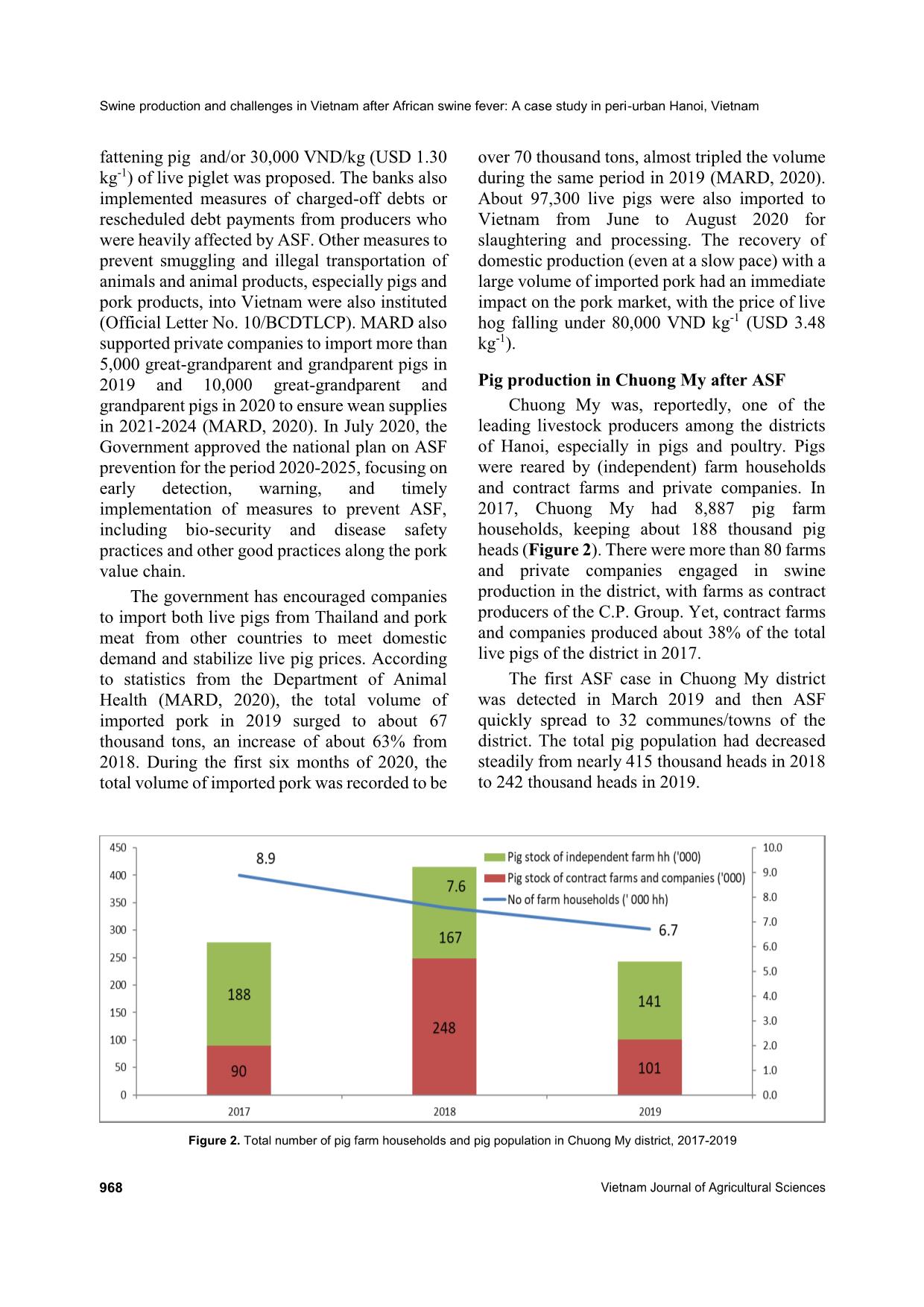
Trang 4
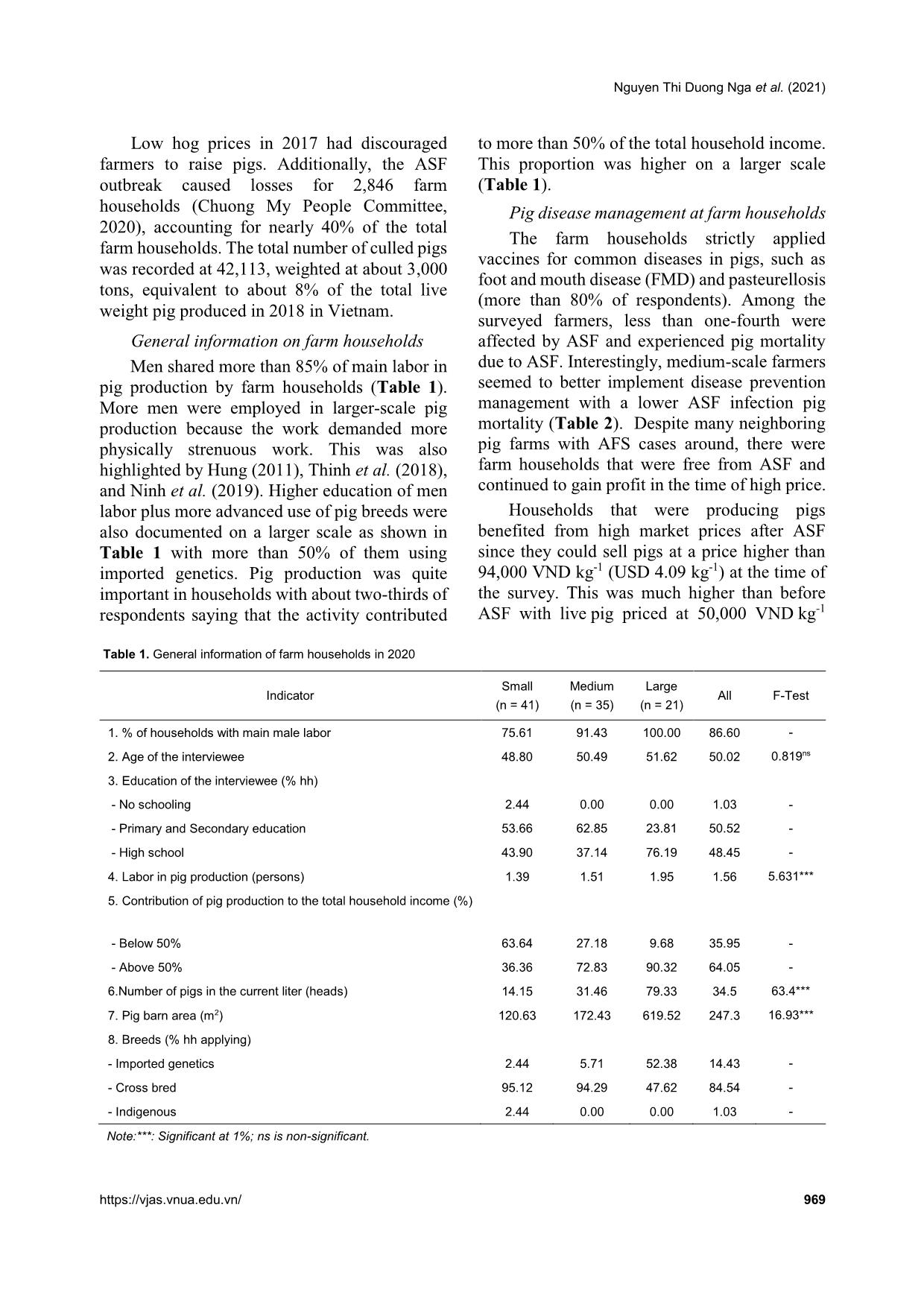
Trang 5
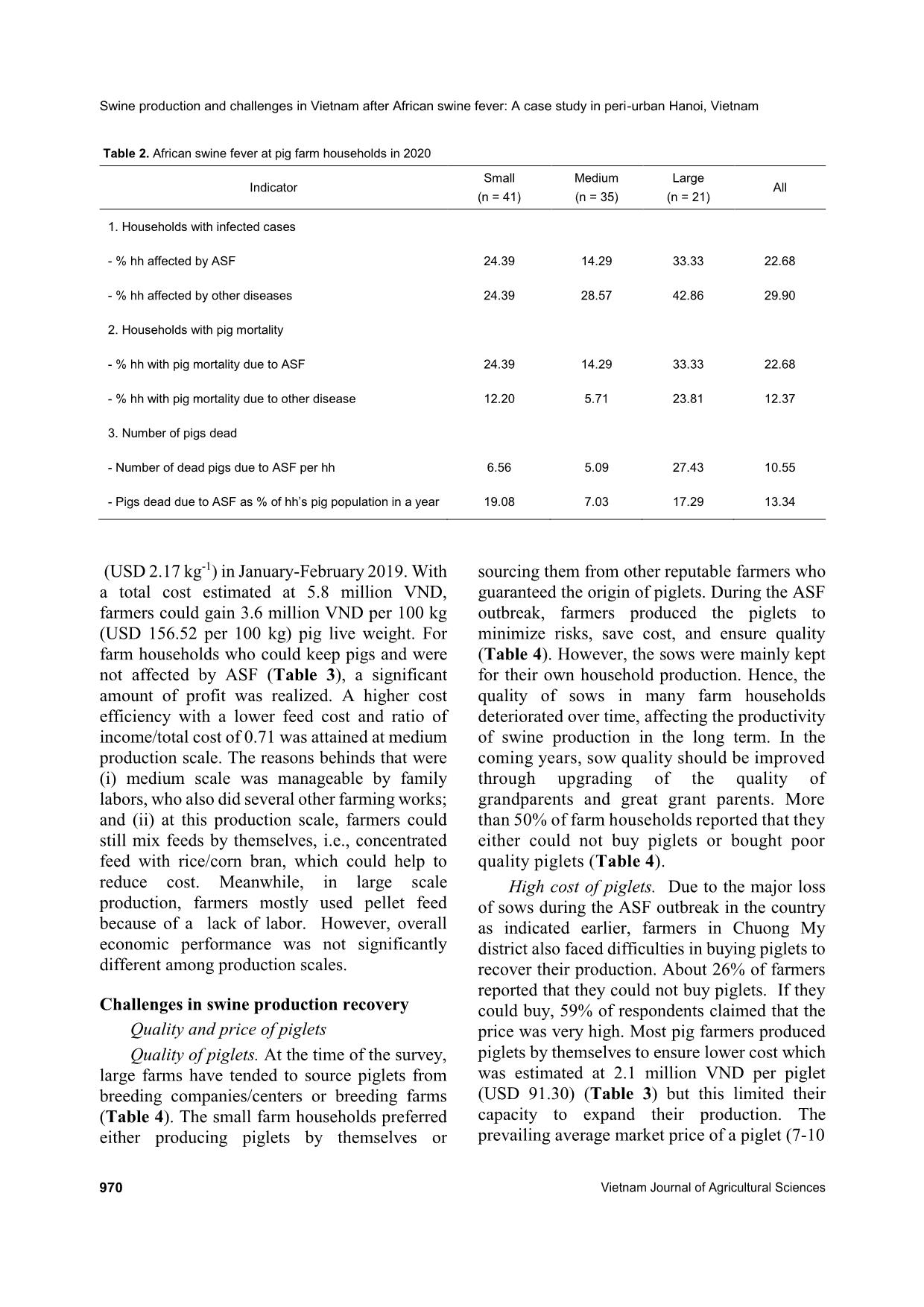
Trang 6
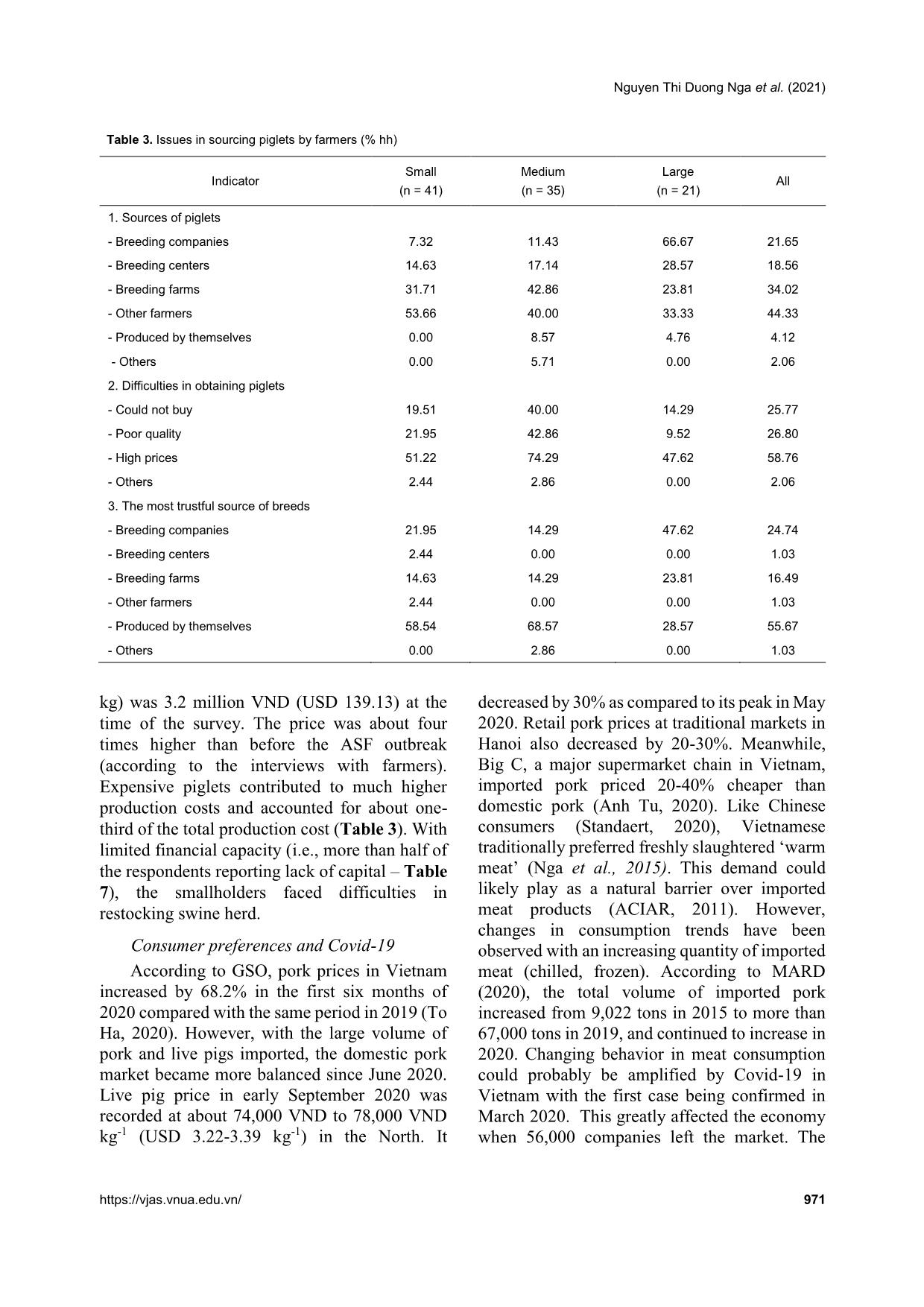
Trang 7
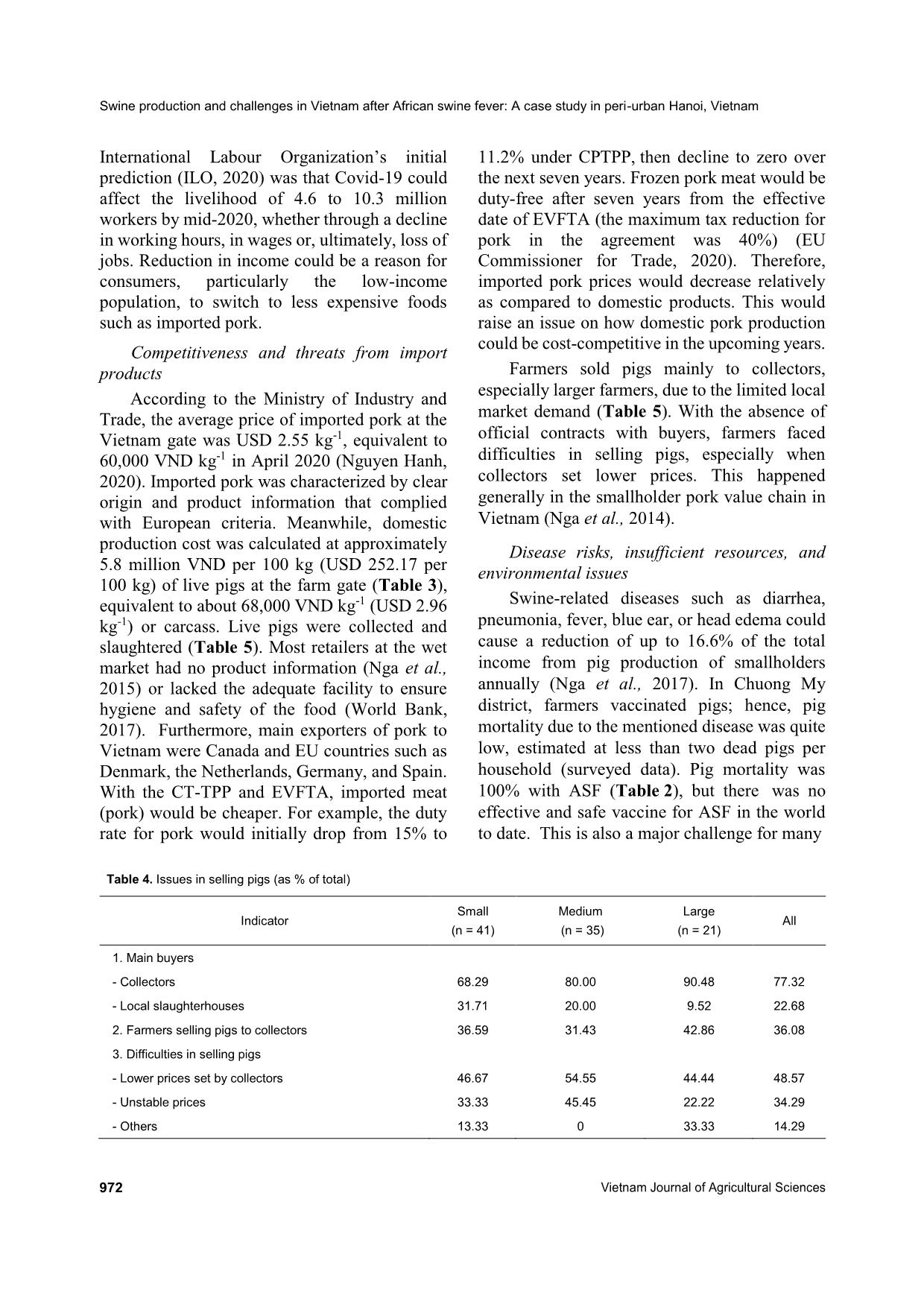
Trang 8
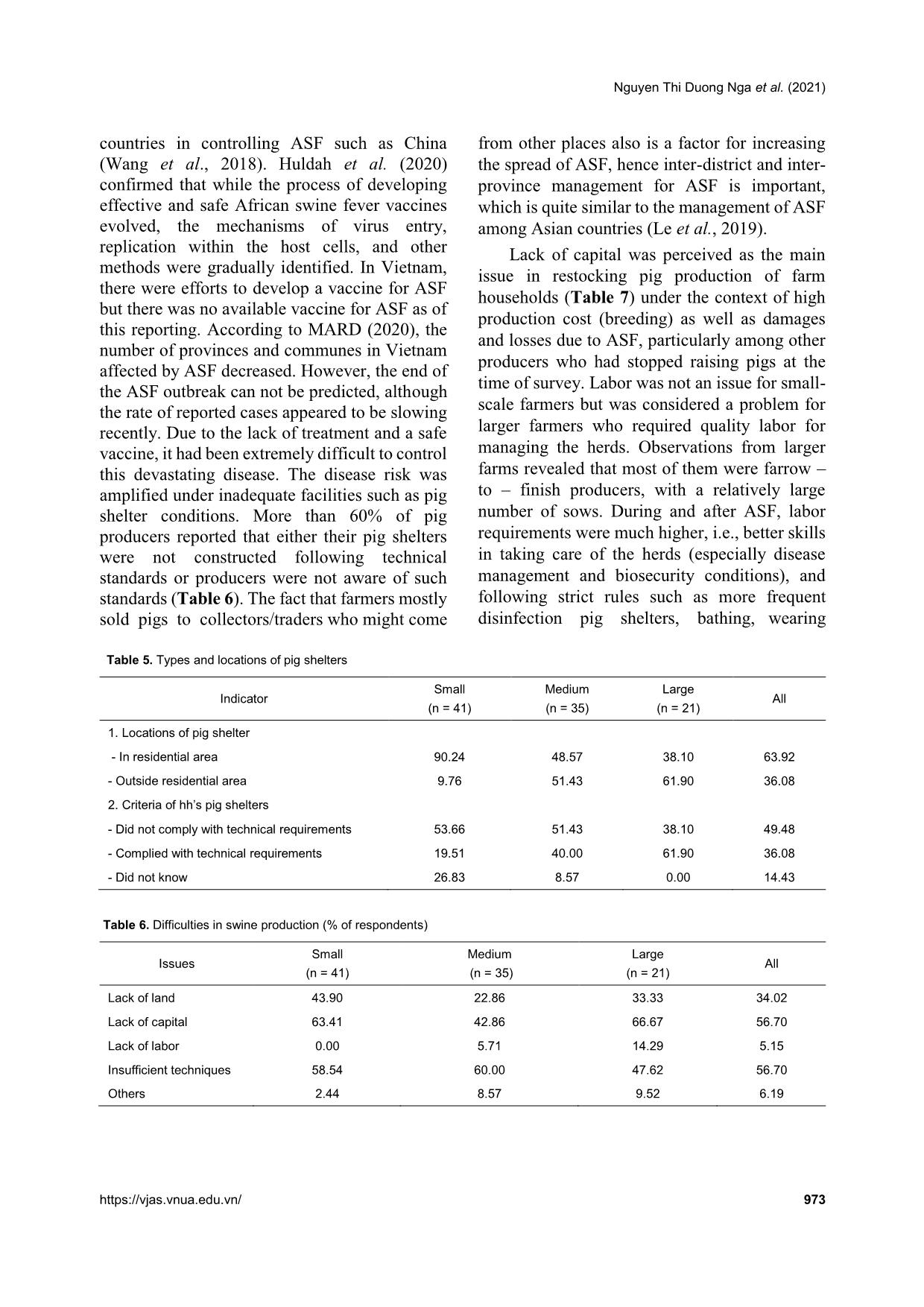
Trang 9
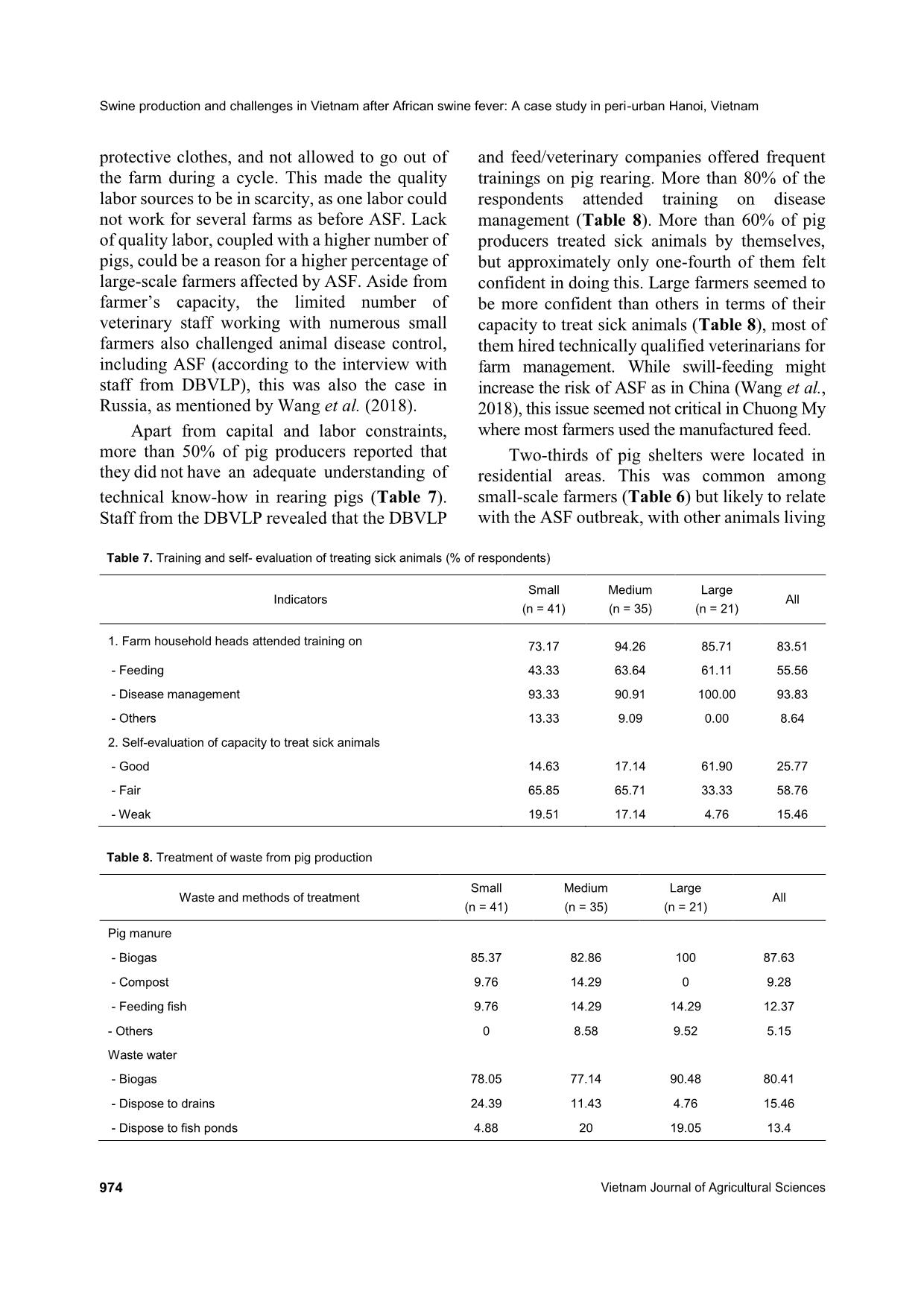
Trang 10
Tải về để xem bản đầy đủ
Tóm tắt nội dung tài liệu: Swine production and challenges in Vietnam after african swine fever: A case study in Peri-Urban Hanoi, Vietnam
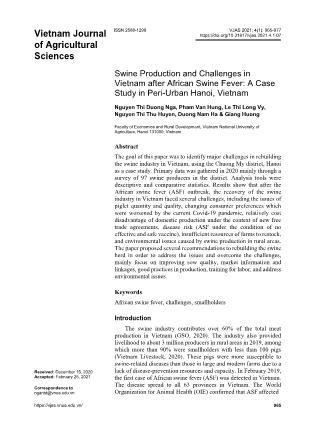
anagement of ASF among Asian countries (Le et al., 2019). Lack of capital was perceived as the main issue in restocking pig production of farm households (Table 7) under the context of high production cost (breeding) as well as damages and losses due to ASF, particularly among other producers who had stopped raising pigs at the time of survey. Labor was not an issue for small- scale farmers but was considered a problem for larger farmers who required quality labor for managing the herds. Observations from larger farms revealed that most of them were farrow – to – finish producers, with a relatively large number of sows. During and after ASF, labor requirements were much higher, i.e., better skills in taking care of the herds (especially disease management and biosecurity conditions), and following strict rules such as more frequent disinfection pig shelters, bathing, wearing Table 5. Types and locations of pig shelters Indicator Small (n = 41) Medium (n = 35) Large (n = 21) All 1. Locations of pig shelter - In residential area 90.24 48.57 38.10 63.92 - Outside residential area 9.76 51.43 61.90 36.08 2. Criteria of hh’s pig shelters - Did not comply with technical requirements 53.66 51.43 38.10 49.48 - Complied with technical requirements 19.51 40.00 61.90 36.08 - Did not know 26.83 8.57 0.00 14.43 Table 6. Difficulties in swine production (% of respondents) Issues Small (n = 41) Medium (n = 35) Large (n = 21) All Lack of land 43.90 22.86 33.33 34.02 Lack of capital 63.41 42.86 66.67 56.70 Lack of labor 0.00 5.71 14.29 5.15 Insufficient techniques 58.54 60.00 47.62 56.70 Others 2.44 8.57 9.52 6.19 Swine production and challenges in Vietnam after African swine fever: A case study in peri-urban Hanoi, Vietnam 974 Vietnam Journal of Agricultural Sciences protective clothes, and not allowed to go out of the farm during a cycle. This made the quality labor sources to be in scarcity, as one labor could not work for several farms as before ASF. Lack of quality labor, coupled with a higher number of pigs, could be a reason for a higher percentage of large-scale farmers affected by ASF. Aside from farmer’s capacity, the limited number of veterinary staff working with numerous small farmers also challenged animal disease control, including ASF (according to the interview with staff from DBVLP), this was also the case in Russia, as mentioned by Wang et al. (2018). Apart from capital and labor constraints, more than 50% of pig producers reported that they did not have an adequate understanding of technical know-how in rearing pigs (Table 7). Staff from the DBVLP revealed that the DBVLP and feed/veterinary companies offered frequent trainings on pig rearing. More than 80% of the respondents attended training on disease management (Table 8). More than 60% of pig producers treated sick animals by themselves, but approximately only one-fourth of them felt confident in doing this. Large farmers seemed to be more confident than others in terms of their capacity to treat sick animals (Table 8), most of them hired technically qualified veterinarians for farm management. While swill-feeding might increase the risk of ASF as in China (Wang et al., 2018), this issue seemed not critical in Chuong My where most farmers used the manufactured feed. Two-thirds of pig shelters were located in residential areas. This was common among small-scale farmers (Table 6) but likely to relate with the ASF outbreak, with other animals living Table 7. Training and self- evaluation of treating sick animals (% of respondents) Indicators Small (n = 41) Medium (n = 35) Large (n = 21) All 1. Farm household heads attended training on 73.17 94.26 85.71 83.51 - Feeding 43.33 63.64 61.11 55.56 - Disease management 93.33 90.91 100.00 93.83 - Others 13.33 9.09 0.00 8.64 2. Self-evaluation of capacity to treat sick animals - Good 14.63 17.14 61.90 25.77 - Fair 65.85 65.71 33.33 58.76 - Weak 19.51 17.14 4.76 15.46 Table 8. Treatment of waste from pig production Waste and methods of treatment Small (n = 41) Medium (n = 35) Large (n = 21) All Pig manure - Biogas 85.37 82.86 100 87.63 - Compost 9.76 14.29 0 9.28 - Feeding fish 9.76 14.29 14.29 12.37 - Others 0 8.58 9.52 5.15 Waste water - Biogas 78.05 77.14 90.48 80.41 - Dispose to drains 24.39 11.43 4.76 15.46 - Dispose to fish ponds 4.88 20 19.05 13.4 Nguyen Thi Duong Nga et al. (2021) https://vjas.vnua.edu.vn/ 975 in the same area (Dione et al., 2015). Backyard swine raising was one of the pressing issues in the rural environment, despite that most of the communes in the district had set areas isolated from the residential area for livestock production. Compost of manure (Table 9) within residential areas (among 10% of pig households) and direct disposal of waste water from pig production to common drainage systems could cause environmental pollution and would pose more difficulties in animal disease management for farm households. There was only one farm household that applied a manure pressing machine and claimed that it was quite efficient in addressing the problem of odor within the area. Conclusions and Recommendations The swine industry continues to be a key player in livestock production of Vietnam in creating livelihoods as well as pork dominance in the consumers’ meat basket. The ASF outbreak has caused devastating losses in the country’s production and food market. MARD and line agencies have taken various measures to control the epidemic. The government has also encouraged meat imports to address the shortfall in the pork supply in the domestic market. Despite the fact that the rate of reported ASF cases seemed to decline, the end of the ASF outbreak could not be predicted. Recovery of the swine industry is urgently called for, which requires a lot of effort to prevent and control ASF and address market-related issues. This study took the case in Chuong My district, Hanoi and show that ASF had a significantly adverse impact on the pig herd of the district, and main challenges in swine production recovery after ASF were identified, such as issues of quantity and quality of piglets and changing consumer preferences which could have been amplified by Covid-19 (ongoing), relatively cost disadvantage of domestic production under the context of new free trade agreements (such as EVFTA and CT- TPP), disease risk (ASF under the condition of no effective and safe vaccine), and insufficient resources of farms to restock, and environmental issues caused by pig production in rural areas. To speed up the recovery of the swine industry in the future, the government and line agencies should focus on improving sow quality through breeding programs to improve the quality of grandparents and great grandparents in breeding units. Cost competitiveness in pig production requires lower production and marketing costs through reduced feed cost as well as breeding cost and building efficient marketing channels with strong linkages along the value chain. The promotion of good agricultural practices in pig production should be intensified, such as VietGAHP or biosecurity, or establishing the disease-free livestock production zone, and discouraging farmers to expand production in residential areas. Training programs to improve farmer’s production capacity and rural laborers in swine production must be offered free or at minimal cost, where rural occupational training programs could also be targeted. This also should be aligned with the National plan on ASF prevention. Government line ministries with partner banks or lending institutions may revisit their credit policies and offer easy and practical solutions to ease credit availability to small farm holders. Market information systems should be efficient to serve numerous small farmers to avoid excess supply (as experienced in the past). Pig waste management, as well as environmental management in the rural areas, should be strengthened. References ACIAR (2011). Improving the Competitiveness of Pig Producers in an Adjusting Vietnam Market. Policy paper, ACIAR Project No. LPS/2005/063. Retrieved from https://core.ac.uk/download/pdf/132667868.pdf on September 13, 2020. Anh Tu (2020). Vietnam’s pork imports surge 300 percent. Retrieved from https://e.vnexpress.net/news/business/industries/vietn am-s-pork-imports-surge-300-percent-4090374.html on September 12, 2020. Chuong My People Committee (2020). Annual socio- economic report, unpublished (in Vietnamese). Dione M. M., Akol J., Roesel K., Kungu J., Ouma E. A., Wieland B. & Pezo D. (2015). Risk factors for African swine fever in smallholder pig production Systems in Swine production and challenges in Vietnam after African swine fever: A case study in peri-urban Hanoi, Vietnam 976 Vietnam Journal of Agricultural Sciences Uganda. Transbound Emerg Dis. 64(3):872-882. DOI: 10.1111/tbed.12452. EU Commissioner for Trade (2020). Guide to The EU- Vietnam Trade and Investment Agreements. Retrieved from https://trade.ec.europa.eu/doclib/docs/2016/june/trado c_154622.pdf on September 13, 2020. Hung P. V. (2011). Commercial pig farms in the context of economic integration: A case study in the Red River delta. Journal of Science and Development. 9(2): 220-230. GSO (2020). Published data on livestock production. Retrieved from https://www.gso.gov.vn/ on September 14, 2020 (in Vietnamese). Guilford J. P. & Frucher B. (1973). Fundamental Statistics in Psychology and Education, New York: MC Graw- Hill does cite Slovin (1960). Huldah S., Gabrielle M., Shehnaz L., Neha S., Uryakant D. W., Richard P. B. & Waithaka M. (2020). Progress Toward Development of Effective and Safe African Swine Fever Virus Vaccines. Frontiers in Veterinary Science. DOI: 10.3389/fvets.2020.00084. ILO (2020). COVID-19 and the labor market in Viet Nam. Retrieved from https://www.ilo.org/wcmsp5/groups/public/---asia/--- ro-bangkok/---ilo- hanoi/documents/briefingnote/wcms_742134.pdf on September 14, 2020. LDP (2020). Total country sow population is above 2.8 million. Retrieved from https://nongnghiep.vn/tong- dan-lon-nai-ca-nuoc-con-tren-28-trieu-con on September 13, 2020 (in Vietnamese). Le V. P., Jeong D. G., Yoon S. W., Kwon H. M., Trinh T. B. N., Nguyen T.L., Bui T. T. N., Oh J., Kim J. B., Cheong K. M.. Tuyen N. V., Bae E., Vu T. T. H., Yeom M., Na. W. & Song D. (2019). Outbreak of African Swine Fever, Vietnam, 2019. Emerging Infectious Diseases. 25(7): 1433-1435. DOI:10.3201/eid2507.190303. MARD (2020). Monthly report on the performance of Agriculture Sector and Rural Development in 2020. Retrieved from https://www.mard.gov.vn/Pages/bao- cao-thong-ke.aspx on September 12, 2020 (in Vietnamese). MARD (2019). Monthly report on the performance of Agriculture Sector and Rural Development in 2019. Retrieved from https://www.mard.gov.vn/Pages/bao- cao-thong-ke.aspx on September 12, 2020 (in Vietnamese). Nga N. T. D., Hung P. V. & Huyen N. T. T. (2017). Estimates of damage loss due to pig disease in smallholders report. Unpublished report, PigRISK project, International Livestock Research Institute. Nga N. T. D., Lapar L., Unger F., Hung P. V., Duong N. H., Huyen N. T. T., Long T. V. & Be D. T. (2015), Household pork consumption behavior in Vietnam: Implications for pro-smallholder pig value chain upgrading. Proceedings, Tropentag Conferences 2015. International Research on Food Security, Natural Resource Management and Rural Development, 16-18/9. Nga N. T. D., Ninh H. N., Hung P. V. & Lapar M. L. (2014). Smallholder pig value chain development in Vietnam: Situation analysis and trends. ILRI. Project Report. Nairobi, Kenya: International Livestock Research Institute (ILRI). Nguyen Hanh (2020). Imported pork price is about 60 thousand dong/kg. Retrieved from https://congthuong.vn/thit-lon-nhap-khau-co-gia- khoang-60-nghin-dongkg-136643.html on September 12, 2020 (in Vietnamese). Nguyen-Viet Hung, Sinh Dang-Xuan, Phuc Pham-Duc, Kristina Roesel, Nguyen Mai Huong, Toan Luu-Quoc, Pham Van Hung, Nguyen Thi Duong Nga, Lucy Lapar & Fred Unger (2019). Rapid integrated assessment of food safety and nutrition related to pork consumption of regular consumers and mothers with young children in Vietnam. Global Food Security. 20: 37-44. Ninh N. T. T., Lebailly P. & Dung N. M. (2019). Labor Division in Pig Farming Households: An Analysis of Gender and Economic Perspectives in the Red River Delta Vietnam. International Journal of Economics and Financial Issues. 9(1): 183-192. Poole N. (2017). Smallholder Agriculture and Market Participation. Rugby, UK: Practical Action Publishing. DOI: 10.3362/9781780449401. Standaert M. (2020). Appetite for 'warm meat' drives risk of disease in Hong Kong and China. Retrieved from https://www.theguardian.com/environment/2020/jan/ 23/appetite-for-warm-meat-drives-risk-of-disease-in- hong-kong-and-china on September 12, 2020. Swinnen J., Colen L. & Maertens M. (2013). Constraints to smallholder participation in high-value agriculture in West Africa. In: Elbehri A (Ed.). Rebuilding West Africa’s Food Potential, FAO/IFAD. Thinh N. T., Lapar M. L. & Galiè A. (2018). Emerging Gender Issues in Vietnam Pig Value Chain. Proceedings: The 9th ASAE International Conference: Transformation in agricultural and food economy in Asia. January 11-13, 2017. Bangkok, Thailand. Thu Ha (2020). Will import live pigs to lower domestic pork price. Retrieved form truong/Se-nhap-khau-lon-song-de-ha-gia-lon-hoi- trong-nuoc/396783.vgp on September 15, 2020 (in Vietnamese). To Ha (2020). Pork price increased about 68.2% averagely. Retrieved athttps://nhandan.com.vn/nhan-dinh/gia- thit-lon-tang-binh-quan-68-2--608482/ on September 15, 2020 (in Vietnamese). Vietnam Livestock (2020). Statistics on livestock production. Retrieved from https://channuoivietnam.com/thong-ke-chan-nuoi/ on September 13, 2020 (in Vietnamese). Nguyen Thi Duong Nga et al. (2021) https://vjas.vnua.edu.vn/ 977 Wang T., Sun Y. & Qiu, H. J. (2018). African swine fever: an unprecedented disaster and challenge to China. Infectious Diseases of Poverty. 7(1):111. DOI: 10.1186/s40249-018-0495-3. World Bank (2017). Vietnam food safety risks management: challenges and opportunities - policy note. Retrieved from https://www.worldbank.org/en/country/vietnam/publi cation/food-safety-risk-management-in-vietnam- challenges-and-opportunities on September 17, 2019.
File đính kèm:
 swine_production_and_challenges_in_vietnam_after_african_swi.pdf
swine_production_and_challenges_in_vietnam_after_african_swi.pdf

